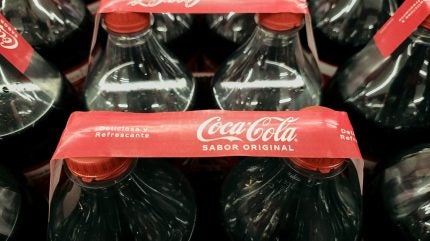
The Coca-Cola Co. has sought to defend changes the company has made to a series of the company’s environmental goals.
In a statement, the Sprite brand owner outlined a set of new goals it has drawn up to cover emissions, packaging and water.
The new targets for 2035 replace a series of goals set for 2030 and Coca-Cola has come under fire in campaign circles for the changes.
“We are prioritising goals and actions that seek to improve water security in high-risk locations, reduce packaging waste and decrease emissions,” a Coca-Cola spokesperson told Just Drinks. “These are complex, challenging areas and to help deliver on our progress, we need more time and more focused resource allocation on issues that are critical to our business and where we can make a meaningful difference.”
On emissions, Coca-Cola had previously set a goal to reduce absolute emissions by 25% by 2030 against a 2015 baseline. The company’s new target is to “aim to reduce the company’s Scope 1, 2 and 3 emissions in line with a 1.5°C trajectory by 2035, from a 2019 baseline”.
The spokesperson said the change in baseline “reflects more recent and improved data” and added the removal of a percentage target underlined Coca-Cola’s bid to focus its efforts.

US Tariffs are shifting - will you react or anticipate?
Don’t let policy changes catch you off guard. Stay proactive with real-time data and expert analysis.
By GlobalData“We are focused on the areas we have the biggest opportunities to make an impact. Key actions we intend to continue to take to reduce emissions include investing in energy-efficient coolers, increasing use of renewable electricity in our operations, incorporating more recycled material into our packaging and working with suppliers to help reduce their emissions.”
Coca-Cola’s previous “environmental update”, which covered up to the end of 2023, set out a range of targets on packaging.
The Costa coffee owner had said it wanted all of its packaging to be recyclable by 2025. In 2023, 90% of Coca-Cola’s packaging was recyclable, it said, the same percentage as 2022.
Before the changes, Coca-Cola had a target for its packaging to contain at least 50% “recycled material” by 2030.
The Diet Coke brand owner, meanwhile, wanted to reduce its use of virgin plastic “derived from non-renewable sources” by 3 million metric tons by 2025 compared to 2020.
2022 also saw the group set a new goal for packaging. It is aiming to have at least a quarter of its beverages sold by volume “in refillable/returnable glass or plastic bottles, or in fountain dispensers with reusable packaging”, again by 2030. The 2023 report said 14% of the company’s beverage volume was sold in reusable packaging – the same proportion as 2022.
Coca-Cola also wanted to “collect and recycle a bottle or can for each one we sell” by 2030. In 2023, the company said it collected 62% of the equivalent bottles and cans it introduced into the market, up from 61% a year earlier.
The group now has two goals on packaging, set for 2035. One is an aim to use 35% to 40% (down from 50%) recycled material in “primary packaging”, which it says is plastic, glass and aluminium. Coca-Cola said it wants to increase its use of recycled plastic from 30% to 35%.
The other is to “ensure the collection of 70% to 75% of the equivalent number of bottles and cans introduced into the market annually”.
The new targets do not include an explicit goal for refillable or reusable packaging but Coca-Cola said it will “continue to invest in refillable packaging where infrastructure already exists”.
The spokesperson added: “We intend to continue to expand the use of refillable packaging in markets where the infrastructure is in place to support this important part of our portfolio and we tailor our refillable packaging approach by market, based on local conditions.”
Ocean-conservation organisation Oceana argued Coca-Cola is “kicking the plastic bottle down the road and into the sea”.
Matt Littlejohn, senior vice president of strategic initiatives at Oceana, added: “Coca-Cola’s decision to double down on single-use plastic – by killing its goals to reduce virgin plastic and to increase reusable packaging – is short-sighted, irresponsible, and worthy of widespread condemnation by its customers, its employees, its investors, and governments worried about the impact of plastics on our oceans and health.”
On water, Coca-Cola now has two goals compared to its previous five.
The company is aiming to return “more than 100% of the water used in finished products globally, on an aggregate level, to nature and communities”. It said it has “met or exceeded” this goal since 2015.
Coca-Cola is also looking to return 100% of the total water used in “more than 200 high-risk locations”.
The Coca-Cola spokesperson said: “We are prioritising goals and actions that seek to improve water security in high-risk locations. The second goal is an update to the goal we had around ‘175 leadership locations’. We intend to continue to focus on promoting water stewardship, increasing water use efficiency and treating and returning safe water to communities.”



